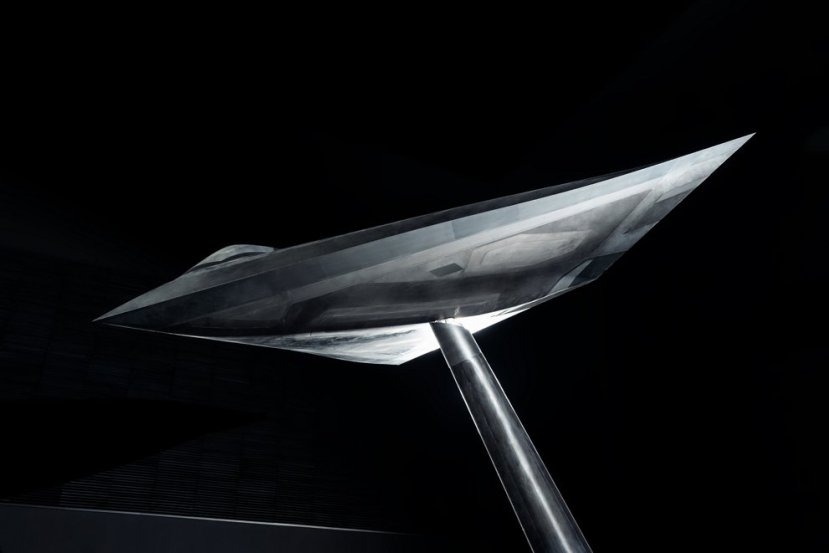First impressions of the Airbus LOUT ‘Diamond Bat’ stealth technology demonstrator

Credit: Airbus
Today, Airbus stunned observers by the revealing the existence of the LOUT low observable unmanned air vehicle testbed. Jim Smith shares his first impressions on this exciting news.
The revelation of the Airbus Defence and Space LO UAV testbed (LOUT) is an interesting development, particularly as it throws down a credibility marker for the Franco-German-Spanish FCAS program, in the same way that Taranis provides a capability indicator for BAE Systems and the Tempest programme.
However, unlike Taranis, LOUT appears to have been focused on exploring the issues associated with designing a credible LO (low observable) concept, rather than building a flying vehicle. So, in some ways, there is a parallel is with earlier UK FOAS (Future Offensive Air System program) and its Replica Demonstrator exploring the issues of fabricating a LO strike aircraft, rather than building a flying demonstrator.


What can we infer from the appearance of the LOUT? It appears to me entirely consistent with the statements reported by Craig Hoyle of FlightGlobal.com, and highlighted on Twitter by Tim Robinson of the Royal Aeronautical Society, and Gareth Jennings.
LOUT has a delta planform with a swept-forward trailing edge, with engine intakes and exhaust on the upper surface of the vehicle. This suggests that the key concern is shielding from ground-based systems, indicative of a design mission focussed on the attack of defended high-value targets.
The stated focus has been on the testing of LO materials, particularly for the engine ducts, and assessing radar signature and IR suppression. Mention was also made of the conduct of aerodynamic testing and acoustic modelling. In addition, LOUT is said to have been used to investigate sensor apertures, and is seen in the photographs to have a cockpit-like feature, and centreline weapons bay.

What else might be inferred from the pictures available, and the statements made by the FCAS program manager, Mario Herzog?
Well, here are some guesses.
My conjecture is that a key role of LOUT is model validation. What do I mean by this? Well, the first step in establishing the confidence and competencies necessary to design a LO air vehicle, is to be able to predict the behaviour of such a vehicle.
To do this one needs the necessary modelling tools to predict the radar, infra-red and acoustic signatures; to predict the aerodynamic characteristics of unusually configured aircraft; to design with confidence propulsion systems, flight control systems and sensors; and to understand the impact of necessary apertures for the weapons bay, cockpit and sensors on both LO design and aircraft configuration.

To ensure that the tools to refine and optimise such a design to meet real, or at least realistic, mission requirements, are reliable and fit for purpose, a demonstrator like LOUD could be very useful. It would provide a reference shape for which aerodynamic, structural, propulsive, signature, control system and sensor models could be developed, and then tested by comparison with ‘real-life’ testing of the demonstrator. The simple shape, and the rather triangular leading-edge profile, are suggestive of this purpose for LOUT, as a step to perhaps a more refined design for which actual flight test could be an objective.
What else? Well, the design is modest in size, but the relevance of this is uncertain. It may be ‘just the right size’ for an affordable LO UAV demonstrator – I am unconvinced that LOUT is intended to actually fly, let alone be a mission capable system. What it is likely to have done is to provide confidence in design methodologies and models which can be applied to a future operational FCAS design, or, indeed, to LO UAV adjuncts to a manned FCAS.
A mission capable system would probably be sized by the carriage of the weapons required to meet its design mission, and by the fuel required to meet the payload-range requirements, with some dependency on the availability of a suitable propulsion system.
Challenges likely to be faced in developing and optimising LOUT-like systems, will include all the usual air vehicle challenges of meeting payload-range and point performance requirements, while also being constrained to provide a solution with low radar, infra-red and acoustic signatures.
In particular, aspects such as designing a flight control system able to cope with highly non-linear aerodynamics, using novel control strategies and effectors to also meet low signature requirements, may prove to be difficult and require innovation.
The inherent characteristics of a near-delta wing are likely to lead to the need to manage relatively high landing speeds, and the lateral-directional characteristics may well result in significant constraints arising from crosswind and/or gust limitations.
— Jim Smith
Special thanks to Jim for a late-night writing session (in Australia) to get this story out quickly)
References – Tweets by Tim Robinson and Gareth Jennings; Article by Craig Hoyle of FlightGlobal.com quoting statements by Mario Herzog, program manager, FCAS
Sadly, this site will pause operations in December if it does not hit its funding targets. If you’ve enjoyed an article you can donate here.

